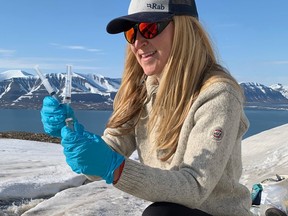A new international study in Norway has identified reservoirs of methane gas leaking from groundwater springs from melting glaciers.
Author of the article:Tiffany Crawford
Published Jul 09, 2023

Proglacial icing formed in front of the rubble of a surging glacier on Svalbard, Norway.
Photo: Gabrielle Kleber PHOTO BY GABRIELLE KLEBER /jpg
Article content
Shrinking glaciers caused by human-induced climate change are causing the release of tonnes of methane gas, according to a new international study that involves the University of B.C.
The study, published this week in the journal Nature Geoscience and led by University of Cambridge and the University Center in Svalbard, Norway, raises serious concerns about hidden sources of emissions, and suggests these emissions be included in climate change calculations.
Co-author Dr. Hal Bradbury, a professor in UBC’s Department of Earth, Ocean and Atmospheric Sciences, says as the planet warms up, disappearing glaciers are causing the formation of bubbling groundwater springs, which are releasing trapped reservoirs of subsurface methane.
He said scientists are worried these emissions released by the Arctic thaw could exacerbate the climate crisis.
The researchers measured methane concentrations from 120 separate springs over three summers in Svalbard, and estimate emissions could exceed 2,000 tonnes annually just from Svalbard.
Bradbury says because this phenomenon occurs in areas with significant permafrost where glaciers are melting, this could also be a problem in the Canadian Arctic or the Russian Arctic.
“When the glaciers retreat due to the increasing temperatures, this leaves behind ground that is not frozen. And when this happens the methane that’s trapped in groundwaters beneath the glaciers then comes out under pressure in these groundwater springs,” Bradbury explained, in an interview Friday.

Article content
Shrinking glaciers caused by human-induced climate change are causing the release of tonnes of methane gas, according to a new international study that involves the University of B.C.
The study, published this week in the journal Nature Geoscience and led by University of Cambridge and the University Center in Svalbard, Norway, raises serious concerns about hidden sources of emissions, and suggests these emissions be included in climate change calculations.
Co-author Dr. Hal Bradbury, a professor in UBC’s Department of Earth, Ocean and Atmospheric Sciences, says as the planet warms up, disappearing glaciers are causing the formation of bubbling groundwater springs, which are releasing trapped reservoirs of subsurface methane.
He said scientists are worried these emissions released by the Arctic thaw could exacerbate the climate crisis.
The researchers measured methane concentrations from 120 separate springs over three summers in Svalbard, and estimate emissions could exceed 2,000 tonnes annually just from Svalbard.
Bradbury says because this phenomenon occurs in areas with significant permafrost where glaciers are melting, this could also be a problem in the Canadian Arctic or the Russian Arctic.
“When the glaciers retreat due to the increasing temperatures, this leaves behind ground that is not frozen. And when this happens the methane that’s trapped in groundwaters beneath the glaciers then comes out under pressure in these groundwater springs,” Bradbury explained, in an interview Friday.

Co-author Dr. Hal Bradbury, a professor in UBC’s Department of Earth, Ocean and Atmospheric Sciences.
Photo: Junyi Sun. PHOTO BY JUNYI SUN JUNYI SUN. /jpg
Previously, research has measured methane release from thawing permafrost but he said this study looked at permafrost and glacier melt and shows there are more sources for this mass methane leak.
“It takes quite a lot of heat to melt the permafrost in the soil. But the (glacier) bases are retreating much faster than the melting of the permafrost.”
Previously, research has measured methane release from thawing permafrost but he said this study looked at permafrost and glacier melt and shows there are more sources for this mass methane leak.
“It takes quite a lot of heat to melt the permafrost in the soil. But the (glacier) bases are retreating much faster than the melting of the permafrost.”
Canada has about 40 per cent of its land area covered by permafrost, so while more research is needed, it’s likely that this methane release could be a significant problem in Canada as well as Norway, he added.
Their findings reveal that the climate-driven glacial melt causes widespread release of methane, creating a feedback loop that could exacerbate global warming.
“When we think about climate change we really need to be considering these feedback cycles. What we’re doing is releasing greenhouse gases, leading to increased temperatures, which causes glacier retreat, leading to more release of greenhouse gases,” said Bradbury.
Between 1936 and 2010, the Svalbard glaciers have overall lost 15 per cent of their mass, although some of the glaciers have lost 30 per cent of their total mass over this period, he said.
What concerns Bradbury the most is that, at this time, the only solution to preventing this massive methane release is to limit global warming, and the planet is not on track to reduce emissions to limit warming to 1.5 C above industrial times.
Bradbury said the amount of emissions being released in Svalbard in the study represents about eight per cent of Norway’s annual oil and gas related emissions.
“At the moment, it’s not a huge number. But one of the reasons why it’s important is that if this continues happening in other areas like Canadian Arctic or the Russian Arctic, we know that there are vast stores of methane in general in these areas. So if we continue having the melting of the glaciers this could potentially lead to much larger releases of methane into the future,” said Bradbury.

Gabrielle Kleber taking water samples for methane analysis on a glacier in Svalbard, Norway.
Photo: Leonard Magerl PHOTO BY LEONARD MAGERL /jpg
Gabrielle Kleber, lead author of the research who is from Cambridge’s Department of Earth Sciences, said the springs are a potentially growing source of methane emissions, and “one that has been missing from our estimations of the global methane budget until now,” according to a statement posted by the university.
Gabrielle Kleber, lead author of the research who is from Cambridge’s Department of Earth Sciences, said the springs are a potentially growing source of methane emissions, and “one that has been missing from our estimations of the global methane budget until now,” according to a statement posted by the university.
No comments:
Post a Comment